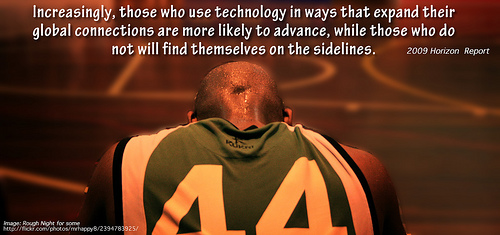At ISTE 2010 in Denver, I attended one of Howard Rheingold’s sessions, “Crap Detection 101.” In this session, Rheingold talked with educators about helping students learn how to wade through the endless amounts of data on the web… but most importantly, helping them discern facts from “crap.” I think a lot of adults could use these skills, in addition to our students.
Another form of “crap detection” that I wish educators would learn is how to know when they’re being taken for a ride courtesy of the Techno-Wow Train.
cc licensed photo shared by thekeithhall
I’m not knocking technology in this post. After spending more than a decade in techno-centric roles, that would be a step back for me. What I do have a problem with is when people use technology to make a fancy-schmancy spreadsheet or “beautiful PowerPoint” (oxymoron?) to present bad information (crap) with a nice, shiny bow or a few amazing bells and whistles.
For example, if I were giving multiple choice tests in my music classroom, and then charting the data into an impressive looking spreadsheet to give to my supervisor, I would hope that my supervisor would ask me how I obtained the data. I would hope that my supervisor would NOT be impressed by the delivery method (the spreadsheet), but would ask good questions about the data.
To clarify my point: in the music classroom, I should be assessing what my students know by having them demonstrate what they have learned. Through a multiple choice test, I can evaluate a student’s memory or understanding at the Knowledge level only. Or… maybe that they are good guessers. What is a quarter note? What is an eighth note? These can be answered on a multiple choice test. Do I really know, through a multiple choice test, if students understand at a deeper level? Absolutely not.
However, if I give those students an activity where they must create their own rhythm patterns using quarter notes and eighth notes, as well as giving them restrictions– I want a rhythm pattern that is two measures long, with four beats per measure– NOW those students must use Application and Synthesis skills to demonstrate what they have learned. I can chart this data just as well as I could chart the multiple choice results.
Which assessment option is better? That’s a no-brainer. BUT… in a spreadsheet of data where I mark “understanding,” how will anyone know what my data represents? It could be the multiple choice data.
I’m really good at making fancy-schmancy spreadsheets. I can make you marvel at my super mad MS Excel skillz. BUT… what do you really want to know about my students? That their teacher can give you the Wow Factor when it comes to presenting data? or that the collected data really means something?


